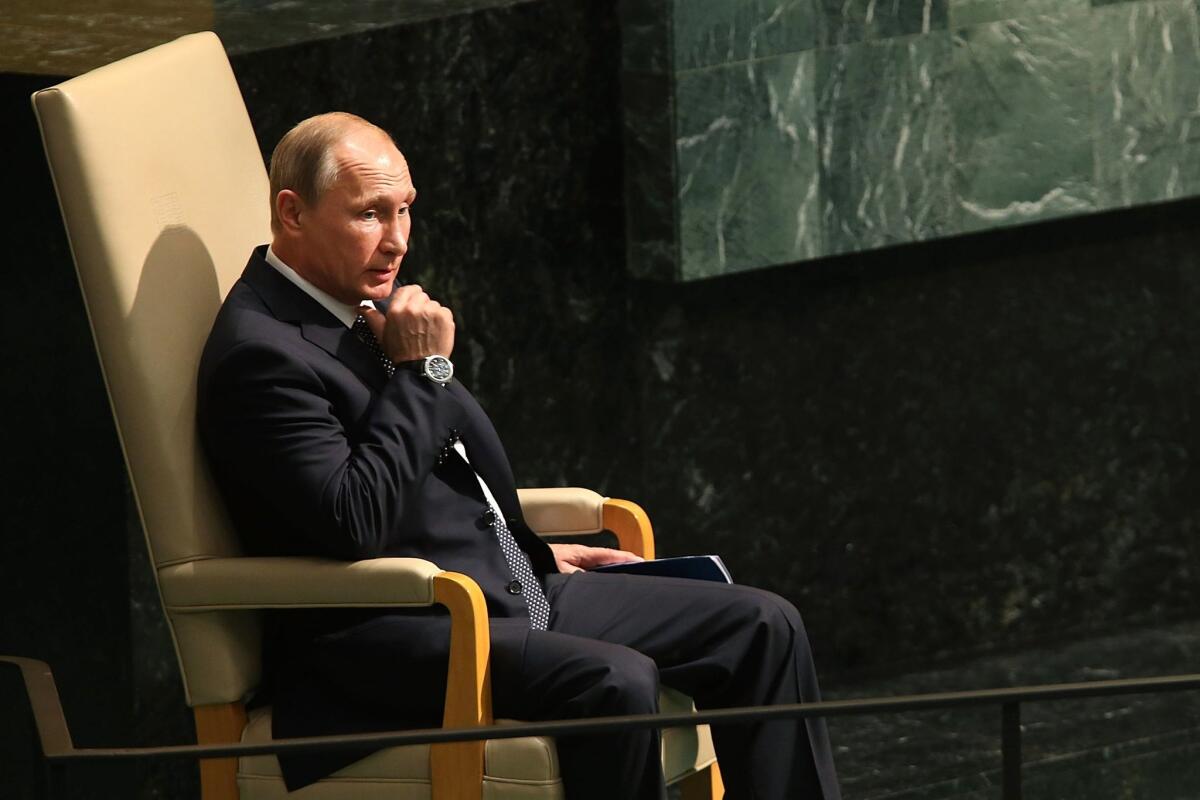Column: What does Russia want in Syria?

Russian President Vladimir Putin sits before speaking at the United Nations General Assembly at U.N. headquarters.
- Share via
Russia’s airstrikes against Syrian rebels last week came as a surprise to many Americans — including, it seems, many in the Obama administration. They shouldn’t have.
Russian President Vladimir Putin and his aides have been bolstering their support of Syria’s president, Bashar Assad, for months — visibly, with troops and aircraft, and volubly as well. The Russians insist that Assad is part of the solution in Syria, not — as President Obama insists — the core of the problem.
When the two presidents met in New York last week, Putin rebuffed Obama’s plea that he pledge to strike only the terrorists of Islamic State, not the moderate rebels the United States has been supporting. (That’s why you haven’t heard U.S. officials charge that Putin broke a promise. He never made one.)
The disagreement between the two governments is fundamental.
In his speech at the United Nations, Putin charged that “some” people, meaning the United States, had tried to foment “democratic” revolutions around the world, including Syria. “Instead of bringing about reforms, aggressive intervention rashly destroyed government institutions and the local way of life.”
“The only way to solve this problem for good is to restore statehood where it has been destroyed,” Putin said, by shoring up “the legitimate government of Syria.”
“There shouldn’t be so much mystification about what the Russians are doing,” Fiona Hill, a leading Putinologist at the Brookings Institution, told me. “They’ve been very consistent and very direct. They’ve been asking: If not Assad, who? They want to see a strongman in place who can keep order.”
What else does Russia want in Syria? Some hawks charge that Putin’s decision looks like a campaign to make Russia a major military power in the entire Middle East. But Hill and other experts describe Russian goals as more limited and practical, and even defensive.
The Assad regime has been Moscow’s most dependable ally in the Middle East for more than 40 years. Assad’s father, President Hafez Assad, asked the Soviet Union for military aid and gave the Soviet Navy a base in Tartus, on the Mediterranean coast, in 1971, when Bashar Assad was 6 years old.
Russia’s initial airstrikes were clearly designed to help Assad defend his home territory in western Syria against a growing rebel threat. That’s why the first targets included units of the U.S.-backed rebel coalition instead of Islamic State, which is concentrated in eastern Syria.
Still, Russia is worried about Islamic State, too. Russian officials say more than 2,000 Russian citizens have joined the extremist group, many of them Muslims from Chechnya, the rebellious republic in southern Russia. “Now that those thugs have tasted blood, we can’t allow them to return home,” Putin said at the U.N.
So Russia is involved in Syria for practical domestic reasons, not merely the pursuit of prestige. But global factors are real, too. Mired in diplomatic isolation by his 2014 invasion of Ukraine, Putin clearly didn’t mind being able to command a meeting with the president of the United States last week.
And that brings us to American policy in Syria, which is, alas, much less clear than Russia’s. While Russia has sent planes and troops to shore up its client, Obama has refused to put American forces directly into the fight, except for airstrikes against Islamic State.
Putin’s policy is ugly — Russian airstrikes produced immediate reports of civilian casualties — but effective for its purpose. Obama’s policy is high-minded and prudent, but it has been painfully ineffective.
U.S. officials think Putin’s strategy will in the long run earn Russia lasting enmity from the Sunni Arabs who are a majority in the Middle East. But in the short run, Putin appears to be getting what he wants: a guaranteed seat at the table.
“If there’s going to be a political process [to end the war], Russia wants to... make sure the United States and its allies don’t get to set the terms,” Hill said. “They are making it clear by use of force that their interests must be taken into consideration.”
That will almost certainly present Obama with an unpalatable choice: accept Assad as part of the solution or counter Russia’s power play by doing more to shore up the rebels favored by the United States.
In his news conference Friday, the president suggested he plans to do neither. “I am under no illusions about what an incredible humanitarian catastrophe this is,” he said. “But … unless we can get the parties on the ground to agree to live together in some fashion, then no amount of U.S. military engagement will solve the problem.”
The president is right that putting U.S. troops on the ground in Syria is a bad idea; a decade of war in Iraq taught the U.S. that lesson. And he’s right that options his critics have proposed, such as a no-fly zone, are not cost-free. But the combination of Putin’s assertiveness and Obama’s hesitance has condemned Syria to many more months of war with no clear path toward a solution.
Twitter: @DoyleMcManus
Follow the Opinion section on Twitter @latimesopinion and Facebook
More to Read
A cure for the common opinion
Get thought-provoking perspectives with our weekly newsletter.
You may occasionally receive promotional content from the Los Angeles Times.











